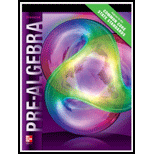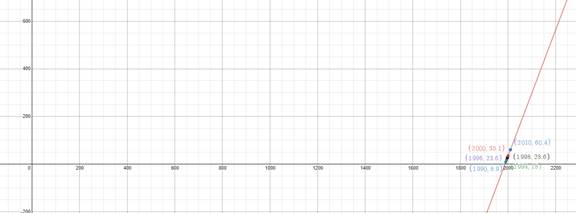
Concept explainers
(a)
To calculate: To make a
(a)
Answer to Problem 8.9.1EP
The scatter plot is created and line of fit is drawn
Explanation of Solution
Given information: Table showing the amount of sales of computers in U.S
| Year | Computer Sales ($ billion) |
| 1990 | 8.9 |
| 1994 | 18.0 |
| 1996 | 23.6 |
| 1998 | 28.6 |
| 2000 | 35.1 |
Calculation:
Given the table showing the amount of sales of computer in U.S
| Year | Computer Sales ($ billion) |
| 1990 | 8.9 |
| 1994 | 18.0 |
| 1996 | 23.6 |
| 1998 | 28.6 |
| 2000 | 35.1 |
On plotting the points on graph and the line of fit is as follows:

Conclusion:
Hence, scatter plot is created and line of fit is drawn
(a)
To calculate: To estimate the computer sales in
(a)
Answer to Problem 8.9.1EP
Computer sales in
Explanation of Solution
Given information: Table showing the amount of sales of computers in U.S
| Year | Computer Sales ($ billion) |
| 1990 | 8.9 |
| 1994 | 18.0 |
| 1996 | 23.6 |
| 1998 | 28.6 |
| 2000 | 35.1 |
Calculation:
Given the table showing the amount of sales of computer in U.S
| Year | Computer Sales ($ billion) |
| 1990 | 8.9 |
| 1994 | 18.0 |
| 1996 | 23.6 |
| 1998 | 28.6 |
| 2000 | 35.1 |
On plotting the points on graph and the line of fit is as follows:

From the graph,
Sales in
Conclusion:
Hence, Computer sales in
(c)
To calculate: To write the equation in slope-intercept form
(c)
Answer to Problem 8.9.1EP
Equation in slope-intercept form is
Explanation of Solution
Given information: Points on line are
Formula Used:
Slope intercept form of line is
Equation of line passing through the points given as
Calculation:
Given the points on line are
Equation of line passing through the points given as
Substituting the values,
Conclusion:
Hence, equation in slope-intercept form is
(d)
To calculate: To find the amount of computer sales in
(d)
Answer to Problem 8.9.1EP
The computer sales in
Explanation of Solution
Given information: Points on line are
Formula Used:
Slope intercept form of line is
Equation of line passing through the points given as
Calculation:
Given the points on line are
Equation of line passing through the points given as
In order to calculate the computer sales in
Conclusion:
Hence, computer sales in
Chapter SH Solutions
Pre-Algebra Student Edition
Additional Math Textbook Solutions
Algebra and Trigonometry (6th Edition)
Calculus: Early Transcendentals (2nd Edition)
Calculus for Business, Economics, Life Sciences, and Social Sciences (14th Edition)
Elementary Statistics: Picturing the World (7th Edition)
Basic Business Statistics, Student Value Edition
- 1) Express these large and small numbers from the Read and Study section in scientific notation: (a) 239,000 miles (b) 3,800,000,000,000 sheets of paper (c) 0.0000000000000000000000167 grams 2) Find all values for the variable x that make these equations true. (a) 5x = 1 (b) 3x = 1/1 9 (c) 4* = 11/ 4 (e) 4* = 64 (g) 10x = 1,000,000 (d) 3x=-3 (f) 2x = = 8 (h) 10x = 0.001arrow_forward(b) 4) Find an equation to fit each of the following graphs: (a) 20 20 18 16 14 12 10 8 6 4 2 24 22 20 18 16 14 12 10 8 16 A 2 -3 -2 -1-0 2 3 4. -1 0 1 2 3. -2 -2arrow_forward3) Which of the following are equivalent to 3? (There may be more than one that is equivalent!) -1 (a) (9)¯¹ 3. (b) (-3)-1 (c) (-3) -1 (d) -(¯3) (e) 11 3-1 (f) 3-4arrow_forward
- Given the following system of equations and its graph below, what can be determined about the slopes and y-intercepts of the system of equations? 7 y 6 5 4 3 2 -6-5-4-3-2-1 1+ -2 1 2 3 4 5 6 x + 2y = 8 2x + 4y = 12 The slopes are different, and the y-intercepts are different. The slopes are different, and the y-intercepts are the same. The slopes are the same, and the y-intercepts are different. O The slopes are the same, and the y-intercepts are the same.arrow_forwardChoose the function to match the graph. -2- 0 -7 -8 -9 --10- |--11- -12- f(x) = log x + 5 f(x) = log x - 5 f(x) = log (x+5) f(x) = log (x-5) 9 10 11 12 13 14arrow_forwardWhich of the following represents the graph of f(x)=3x-2? 7 6 5 4 ++ + + -7-6-5-4-3-2-1 1 2 3 4 5 6 7 -2 3 -5 6 -7 96 7 5 4 O++ -7-6-5-4-3-2-1 -2 -3 -4 -5 -7 765 432 -7-6-5-4-3-2-1 -2 ++ -3 -4 -5 -6 2 3 4 5 6 7 7 6 2 345 67 -7-6-5-4-3-2-1 2 3 4 5 67 4 -5arrow_forward
- 13) Let U = {j, k, l, m, n, o, p} be the universal set. Let V = {m, o,p), W = {l,o, k}, and X = {j,k). List the elements of the following sets and the cardinal number of each set. a) W° and n(W) b) (VUW) and n((V U W)') c) VUWUX and n(V U W UX) d) vnWnX and n(V WnX)arrow_forward9) Use the Venn Diagram given below to determine the number elements in each of the following sets. a) n(A). b) n(A° UBC). U B oh a k gy ท W z r e t ་ Carrow_forward10) Find n(K) given that n(T) = 7,n(KT) = 5,n(KUT) = 13.arrow_forward
 Algebra and Trigonometry (6th Edition)AlgebraISBN:9780134463216Author:Robert F. BlitzerPublisher:PEARSON
Algebra and Trigonometry (6th Edition)AlgebraISBN:9780134463216Author:Robert F. BlitzerPublisher:PEARSON Contemporary Abstract AlgebraAlgebraISBN:9781305657960Author:Joseph GallianPublisher:Cengage Learning
Contemporary Abstract AlgebraAlgebraISBN:9781305657960Author:Joseph GallianPublisher:Cengage Learning Linear Algebra: A Modern IntroductionAlgebraISBN:9781285463247Author:David PoolePublisher:Cengage Learning
Linear Algebra: A Modern IntroductionAlgebraISBN:9781285463247Author:David PoolePublisher:Cengage Learning Algebra And Trigonometry (11th Edition)AlgebraISBN:9780135163078Author:Michael SullivanPublisher:PEARSON
Algebra And Trigonometry (11th Edition)AlgebraISBN:9780135163078Author:Michael SullivanPublisher:PEARSON Introduction to Linear Algebra, Fifth EditionAlgebraISBN:9780980232776Author:Gilbert StrangPublisher:Wellesley-Cambridge Press
Introduction to Linear Algebra, Fifth EditionAlgebraISBN:9780980232776Author:Gilbert StrangPublisher:Wellesley-Cambridge Press College Algebra (Collegiate Math)AlgebraISBN:9780077836344Author:Julie Miller, Donna GerkenPublisher:McGraw-Hill Education
College Algebra (Collegiate Math)AlgebraISBN:9780077836344Author:Julie Miller, Donna GerkenPublisher:McGraw-Hill Education





